

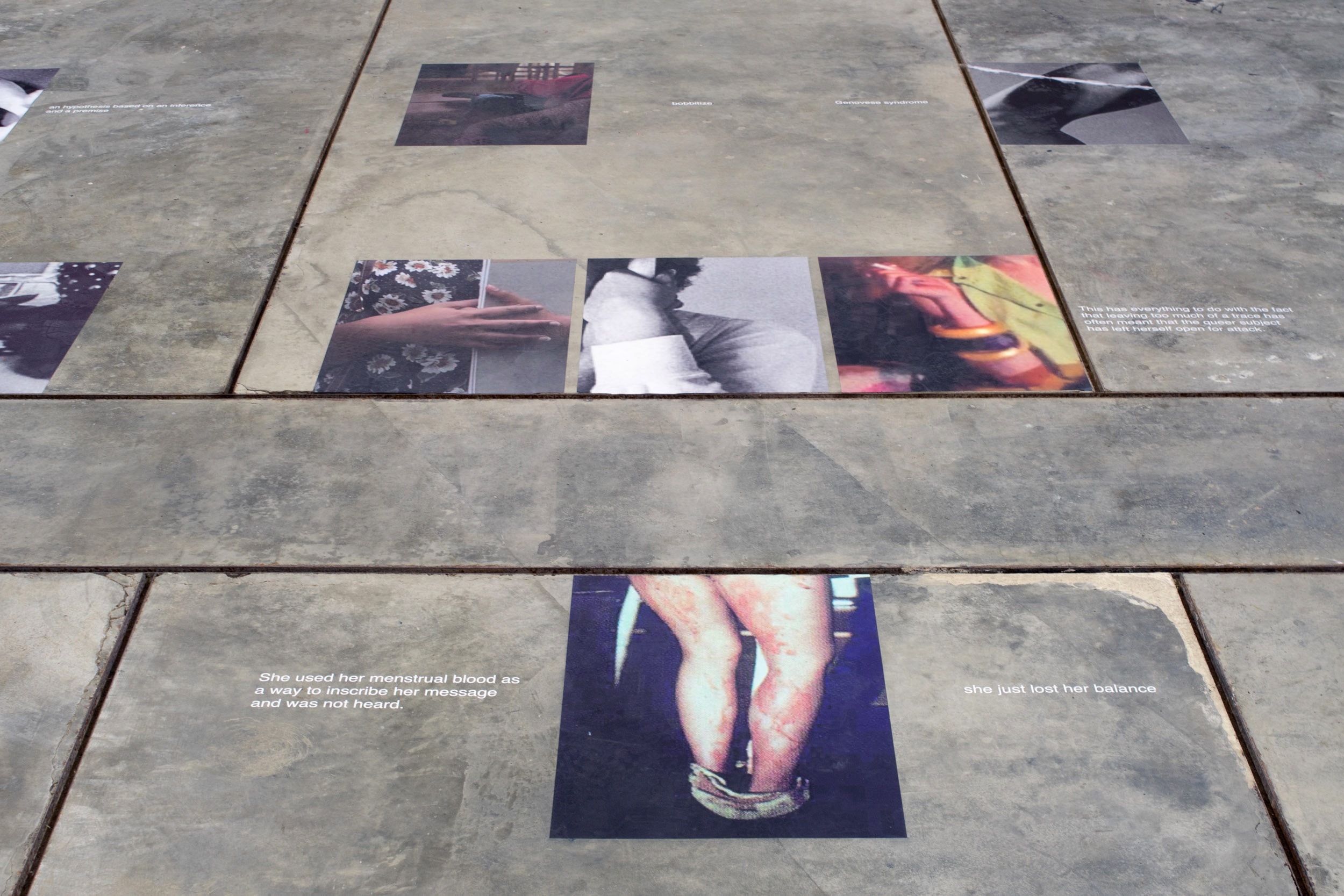

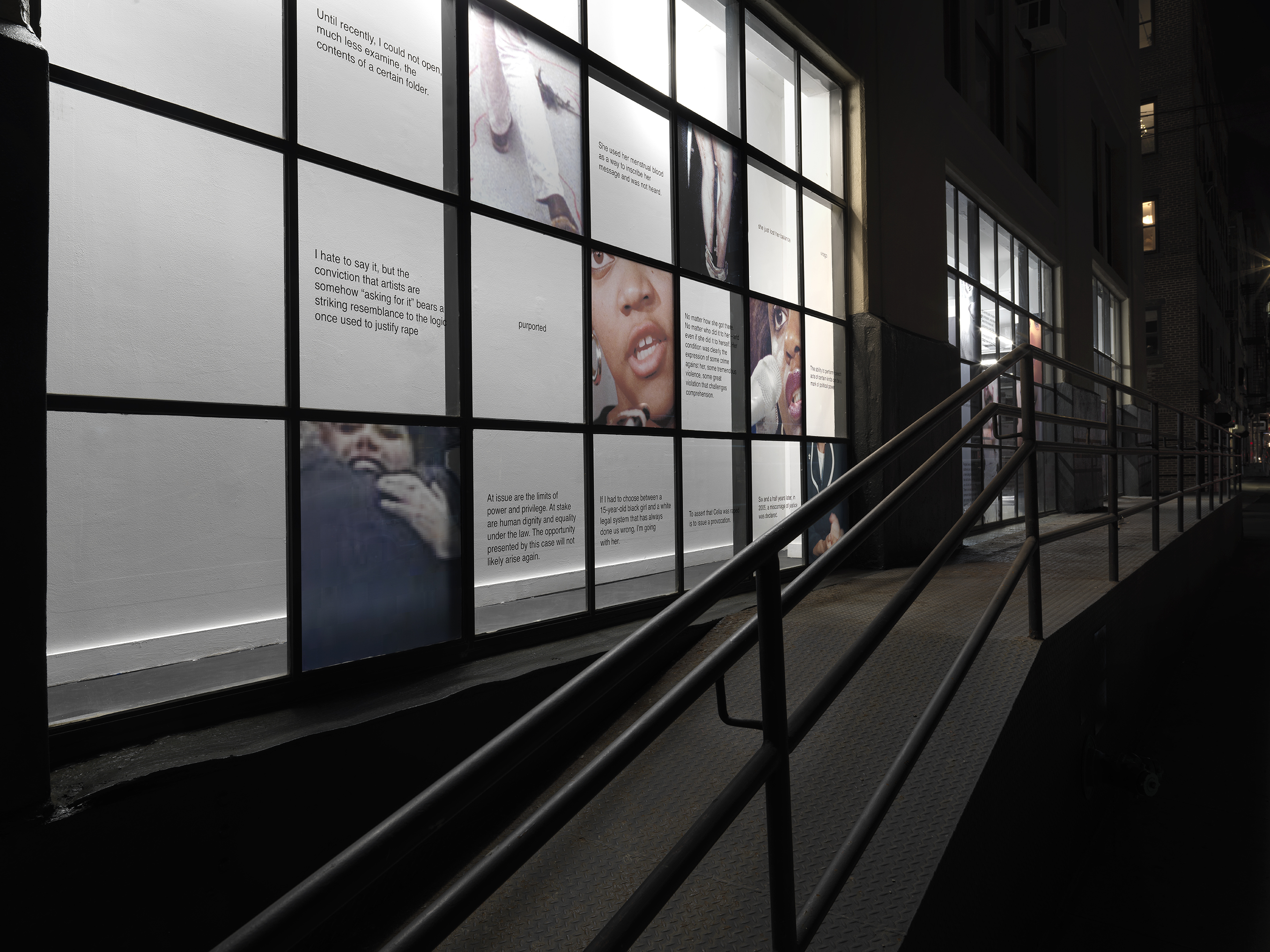
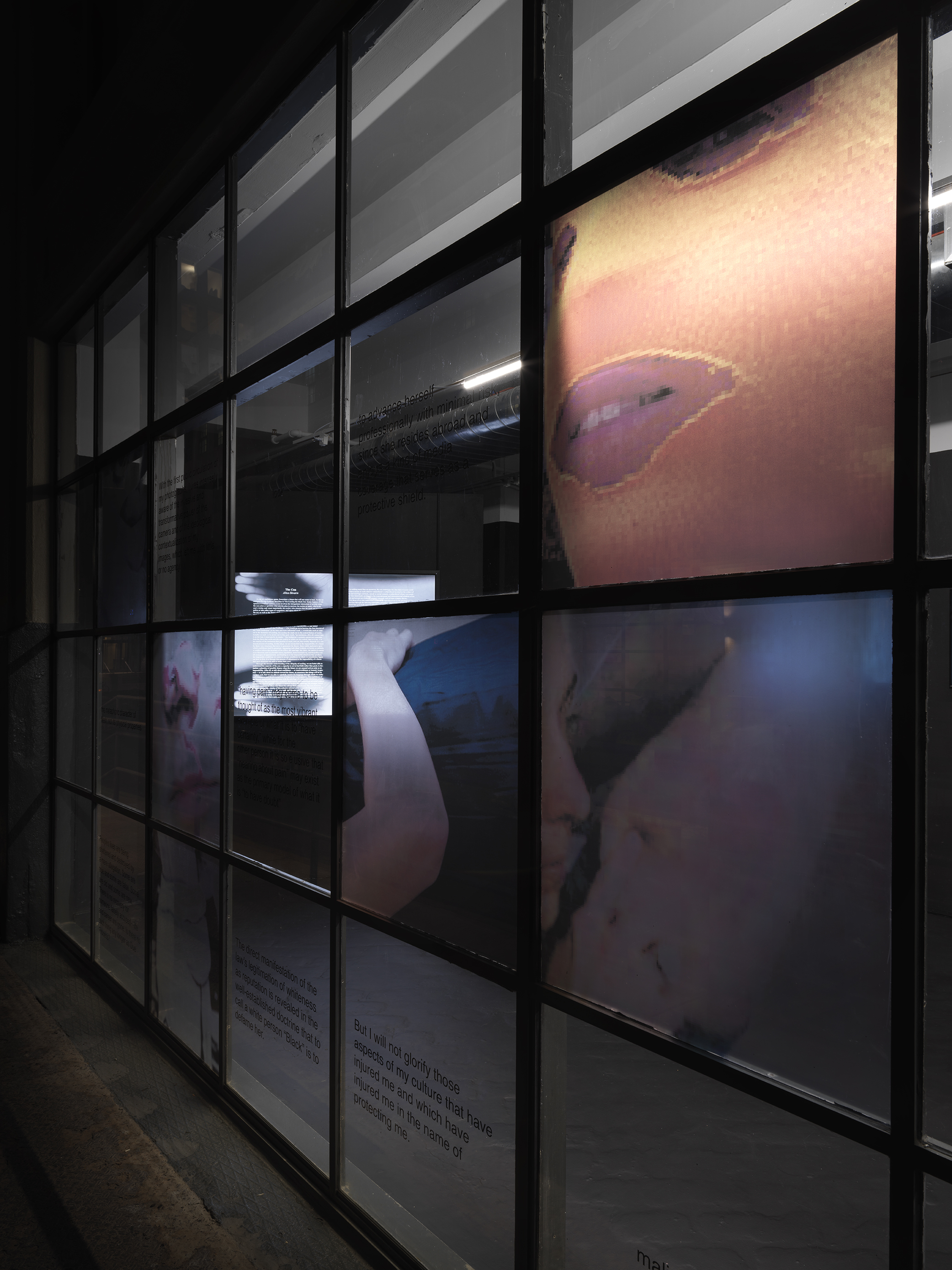
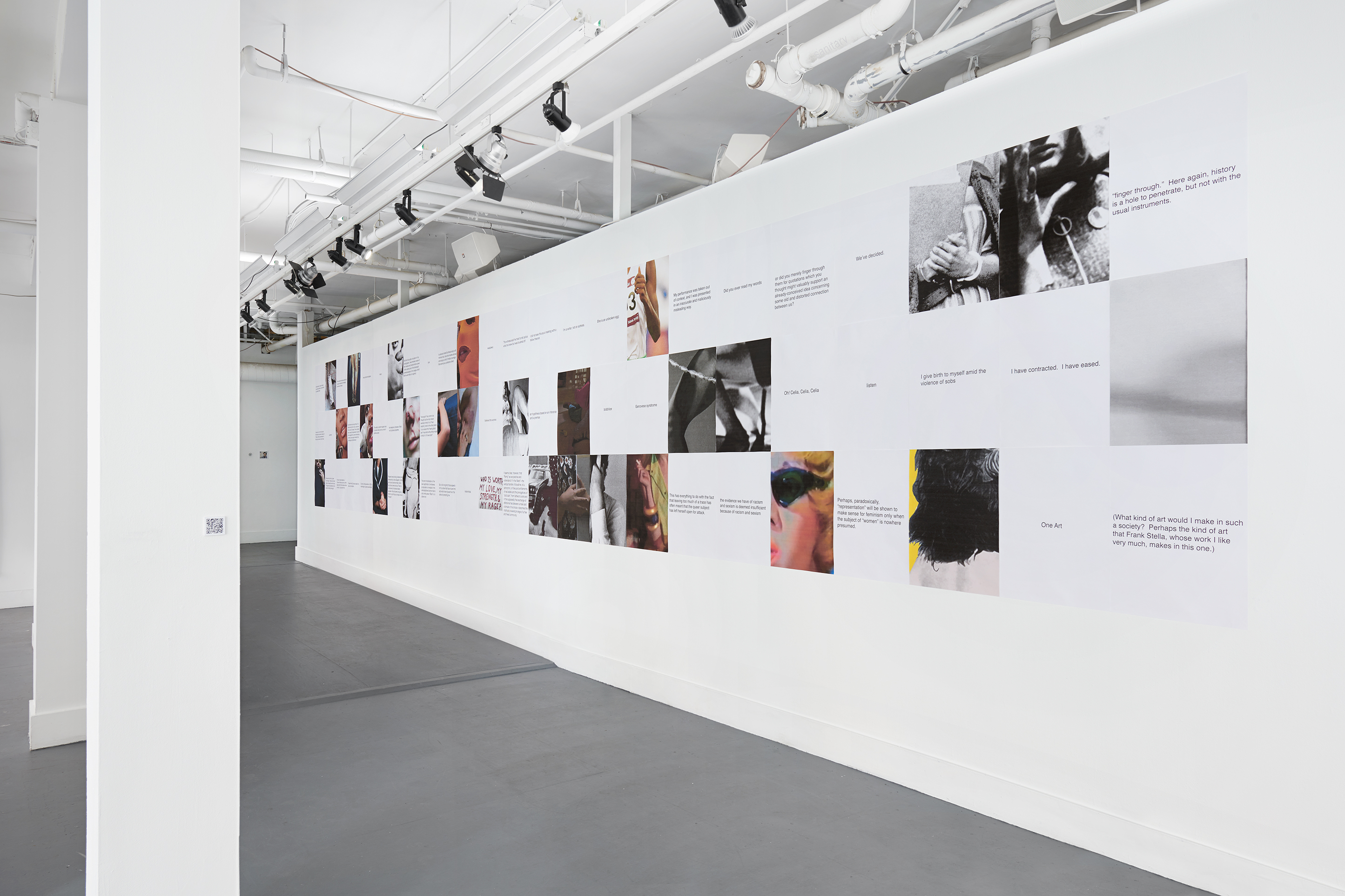


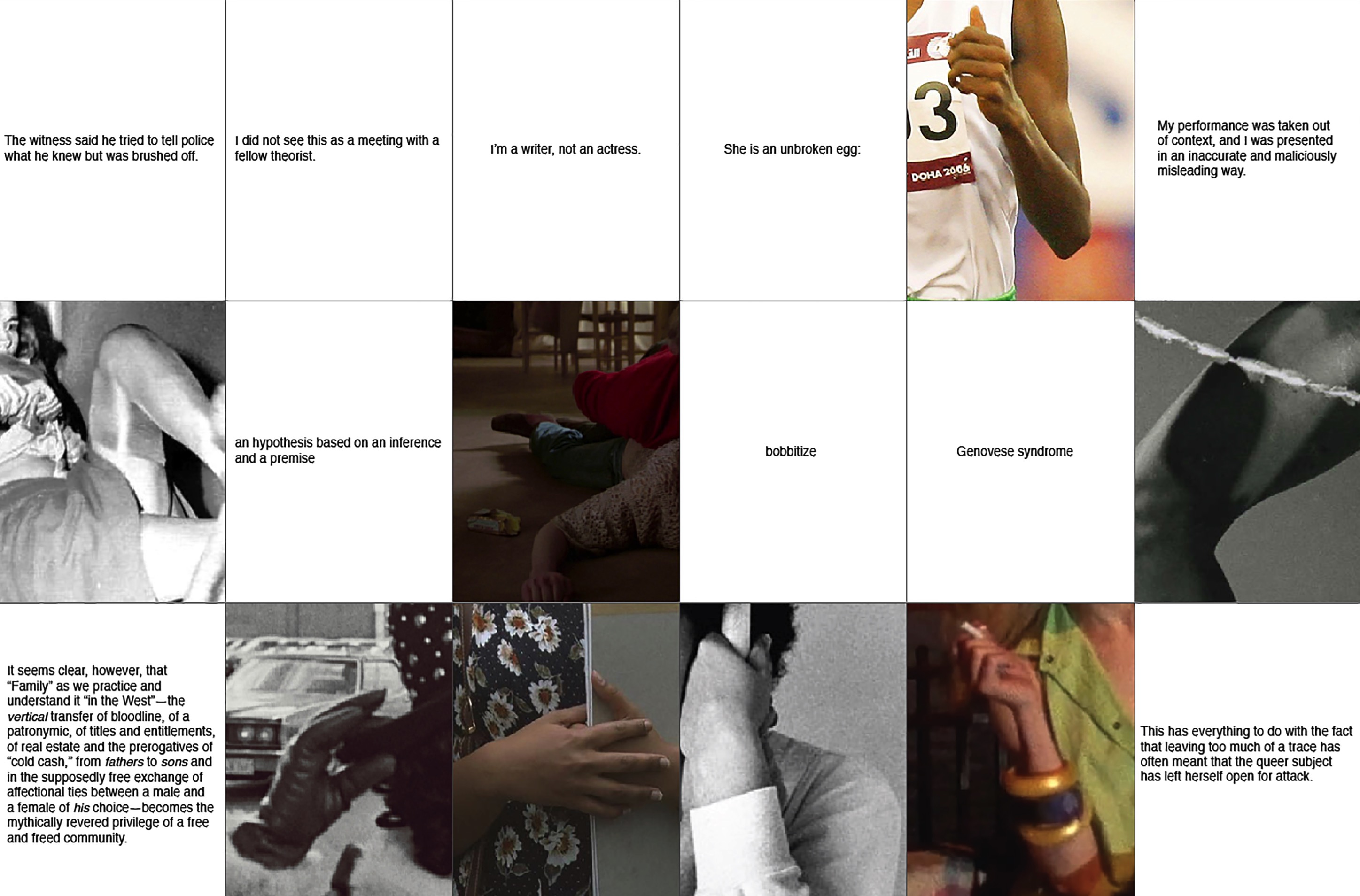
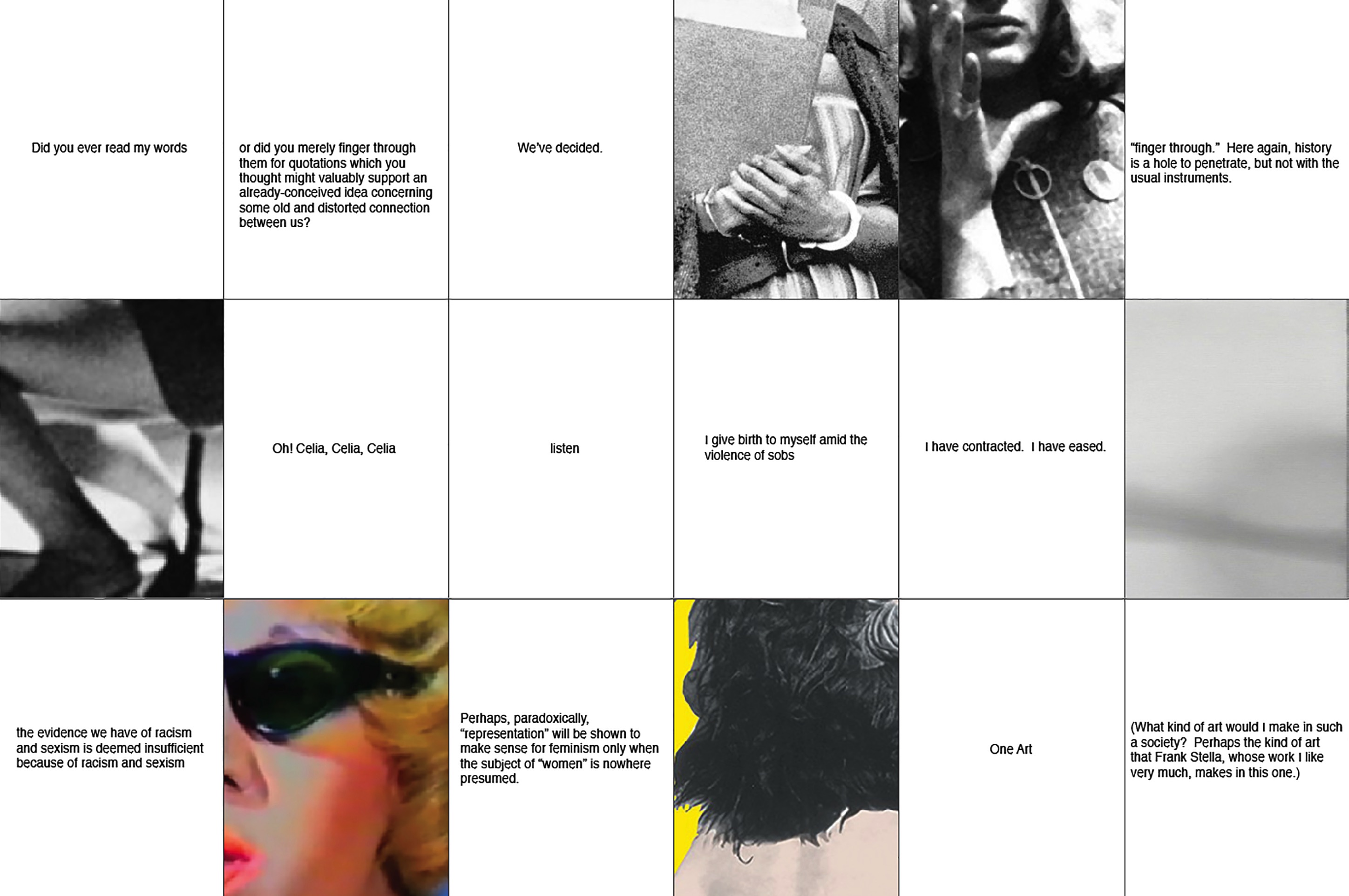
Cite/Site (2018, 2019, 2020)
variable
The 72 images and texts that compose Cite/Site display enlarged fragments of highly-circulated digital images and quotations. All are visual or discursive artifacts of feminine interdiction—that is, moments when women tried to speak on behalf of themselves, or behalf of each other, and were not believed. The work is organized into four stanzas, three rows of six images/texts each. It is installed differently for each exhibition in a way that responds to the physical space.
Stanza 1
Top left to bottom right: Mary Kelly, Imaging Desire (Cambridge, MA: MIT Press, 1998) xv; Suzanne Lacy, Three Weeks in May (1977); Gayatri Spivak, “If Only” The Scholar & Feminist Online, 4:2 (Spring 2006); Ana Mendieta, Untitled (Rape Scene) (1973); Carl Andre in interview with Calvin Tompkins, “The Materialist: Carl Andre's Eminent Obscurity,” The New Yorker (December 5, 2011); virago; Andrea Fraser, “In Conversation: Andrea Fraser,” The Brooklyn Rail, 1 October 2004; purported; Tawana Brawley, 1988; Patricia J. Williams, The Alchemy of Race and Rights (Cambridge, MA: Harvard University Press, 1991) 169-70; Anita Hill, 1991; Rae Langton, “Speech Acts and Unspeakable Acts,” Philosophy & Public Affairs 22:4 (Autumn, 1993) 299; Monica Lewinsky, 1997; “Text of [Paula] Jones Appeal,” The Washington Post, 31 July 1998; Greg Howard, “Al Sharpton, Reconsidered,” The New York Times, 9 March 2018; Saidiya V. Hartman, Scenes of Subjection: Terror, Slavery, and Self-Making in Nineteenth-Century America (New York: Oxford University Press, 1997) 83; Breda O'Brien, “Miscarriage of Justice: Paul McCabe and Nora Wall,” Studies: An Irish Quarterly Review, 95:380 (Winter 2006): 355-364; Patsy Ramsey, 1997.
Stanza 2
Top left to bottom right: Simone Mareuil, 1929; Angela Y. Davis, “Afro Images: Politics, Fashion, and Nostalgia,” Critical Inquiry (Autumn 1994) 39; look; Coco Fusco, “On the Detention of Cuban Artist Tania Bruguera,” e-flux journal, 3 January 2015; A protester is arrested during a demonstration in front of the Russian consulate in support of Russian punk band Pussy Riot, Friday, Aug. 17, 2012 in New York; Kathy O'Dell, Contract with the Skin: Masochism, Performance Art, and the 1970s (Minneapolis: University of Minnesota Press, 1998) 21; Bryn Kelly, “MY TRANS BODY, MY TRANS SELF,” 16 October 2013; Elaine Scarry, The Body in Pain (New York: Oxford University Press, 1985) 4; Emma Sulkowicz, Carry That Weight, 2015; Tania Bruguera, 2015; Mitch McConnel, 13 Nov 2017; Donald Trump, 11 Feb 2018; Alice J. Rhinelander (composograph), New York Evening Graphic, 1925; Cheryl Harris, “Whiteness as Property,” Harvard Law Review, 106:8 (June 1993), 1735; Gloria Anzaldúa, Borderlands/La Frontera: The New Mestiza (San Francisco, CA: Aunte Lute Books, 1987), 21; malinchista; Mark Aguhar, Not You (Power Circle), 2011
Stanza 3
Top left to bottom right: Shayne Jacobs, “DA reopens unsolved 1992 case involving the 'saint of gay life'”, The Daily News, 16 December 2012; Shulamith Firestone, “I Remember Valerie Solanas,” Airless Spaces (New York: Semiotext(e), 1998) 131; “Actress Shoots Andy Warhol,” The Daily News, 1 June 1968: A1; Angela Carter, “In the Company of Wolves,” The Bloody Chamber and Other Stories (New York: Penguin Books, [1979] 2011) 146; Santhi Soundarajan, 2006; Karen Finley, “Chocolate-Smeared Young Woman,” The Washington Post, 19 May 1990: A23; Frances Farmer, 1943; Peggy Phelan, Unmarked: The Politics of Performance, (New York: Routledge, 1996) 139; Maria Schneider, Last Tango in Paris, 1972; bobbitize; Genovese syndrome; Carolee Schneeman, Interior Scroll (1975); Hortense Spillers, “Mamma's Baby, Poppa's Maybe,” Diacritics, 17:2, Culture and Countermemory: The "American" Connection. (Summer 1987): 74; Linda Taylor, 1974; August Jackson, 1997; Norma McCorvey, c. 1982; Venus Extravaganza, c. 1987; José Esteban Muñoz, “Ephemera as Evidence: Introductory Notes to Queer Acts,” Women& Performance, 8:2 (1996): 6.
Stanza 4
Top left to bottom right: Audre Lorde, "Open Letter to Mary Daly," This Bridge Called My Back, ed. Cherríe Moraga and Gloria Anzaldúa, (Albany, NY: SUNY Press, [1981] 2015) 91; June and Jennifer Gibbons, quoted by Marjorie Wallace, "The Tragedy of a Double Life," The Guardian, 12 July 2003; Assata Shakur, 1977; Sylvia Rivera, 1973; Elizabeth Freeman, Time Binds: Queer Temporalities, Queer Histories (Durham, NC: Duke University Press, 2010) 109; Shigeko Kubota, Vagina Painting, 1965; Jonathan Swift, "The Lady's Dressing Room", 1732; listen; Julia Kristeva, Powers of Horror: An Essay on Abjection, trans. Leon S. Roudiez (New York: Columbia University Press, 1982) 3; Gwendolyn Brooks, "The Mother," 1963; Mako Idemitsu, What A Woman Made, 1973; Sara Ahmed, "Evidence," feministkilljoys.com, 12 July 2016; Howardena Pindell, Free, White and 21 (1980); Judith Butler, Gender Trouble: Feminism and the Subversion of Identity (New York: Routledge, [1990] 2006) 8; The Guerilla Girls, Do women have to be naked to get into the Met. Museum? (1989); Elizabeth Bishop, "One Art," 1976; Adrian Piper, Out of Order, Out of Sight, Vol 1: Selected Writings in Meta-Art (Cambridge, MA: MIT Press, 1996) 246.